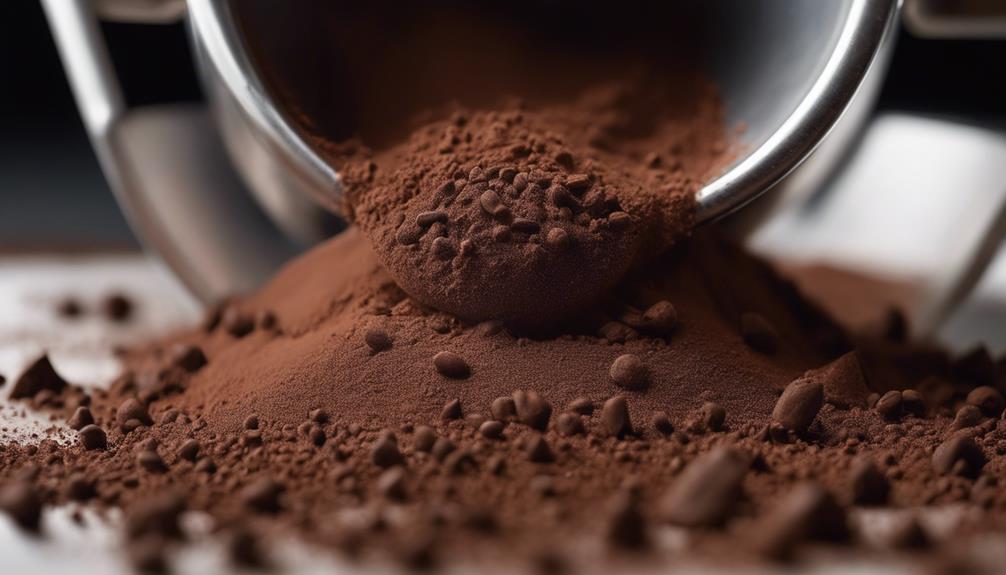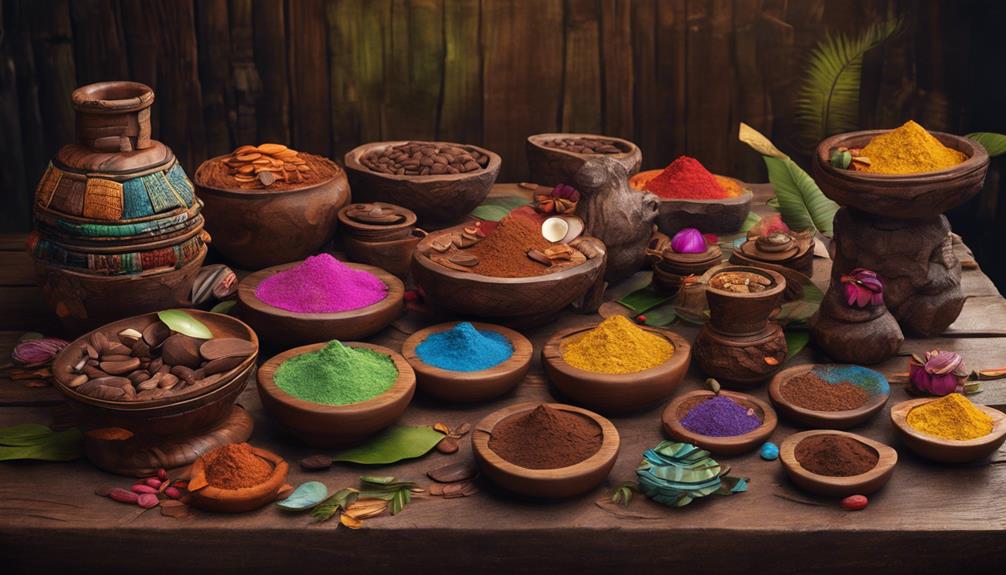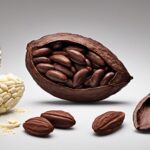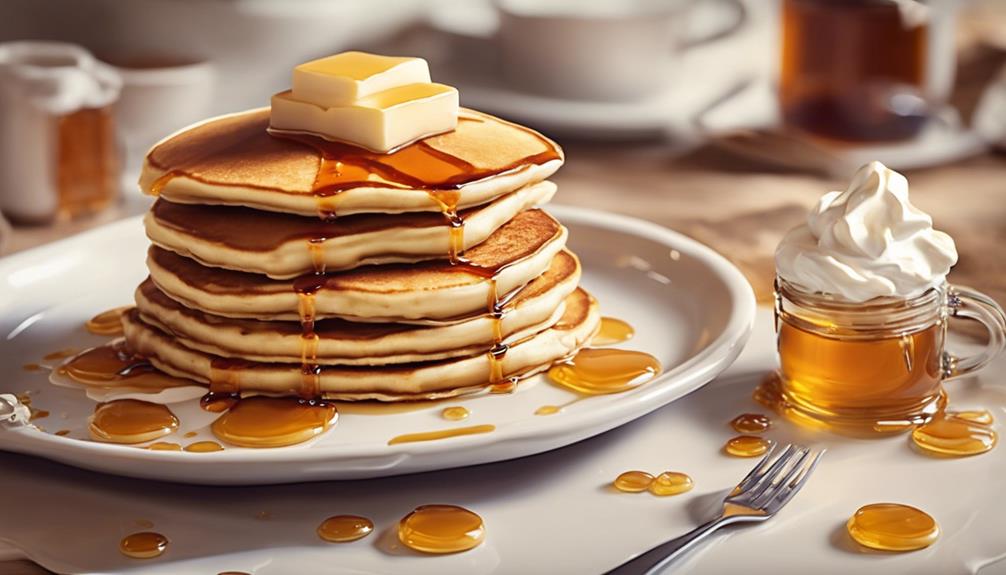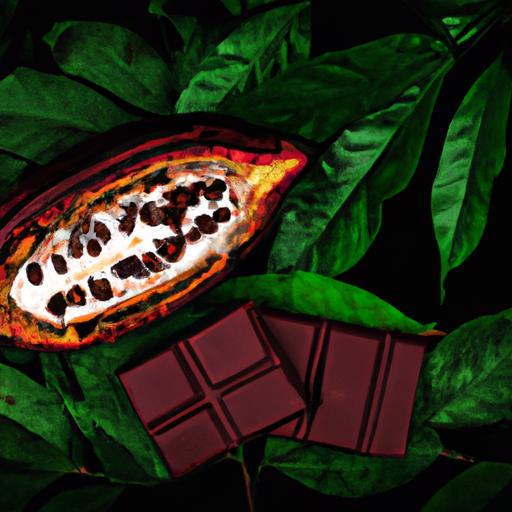When delving into the caffeine content of cocoa powder, it’s crucial to note that the levels can differ depending on factors such as the source of the cocoa beans. African cocoa beans, particularly those that are well-fermented, usually contain lower amounts of caffeine compared to other varieties. For individuals interested in learning more about the caffeine content in cocoa powder, this information reveals the intricate nature of this common ingredient found in our beloved treats.
Key Takeaways
- Cocoa powder contains caffeine ranging from 0.1-0.5%.
- Well-fermented African cocoa beans have lower caffeine levels.
- Processing techniques impact caffeine levels in cocoa products.
- Caffeine in cocoa is naturally occurring, not added during production.
- Cocoa itself has higher caffeine content than chocolate bars.
Caffeine Content in Cocoa Powder
While cocoa powder contains caffeine ranging from 0.1-0.5%, the levels can vary depending on factors such as the origin and fermentation process of the cocoa beans. This means that well-fermented African cocoa beans tend to have lower caffeine levels in cocoa powder compared to other varieties.
When we talk about the amount of caffeine in cocoa powder, it's crucial to note that on average, there are around 12 milligrams of caffeine per tablespoon. Surprisingly, natural cocoa powders generally contain higher levels of caffeine compared to chocolates, making cocoa powder a slightly more stimulating choice.
Despite this, cocoa powder is still known for its health benefits due to the presence of cocoa solids, which are rich in antioxidants and flavonoids that can promote heart health and overall well-being. So, while enjoying your cocoa-infused treats, remember that besides the delightful taste, you're also getting a little boost from the caffeine content.
Comparing Cocoa With Coffee and Tea
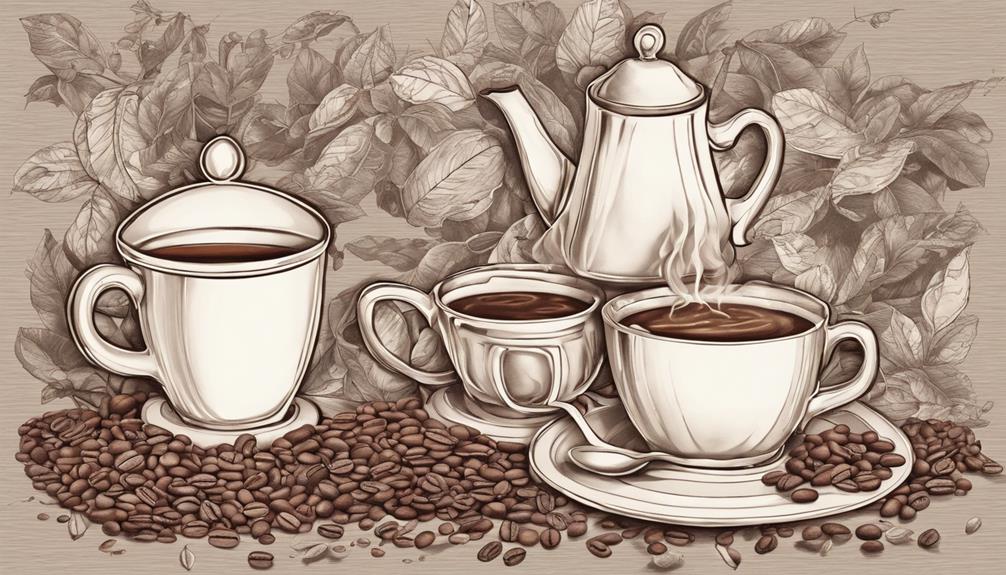
Often overlooked, the comparison between cocoa, coffee, and tea reveals distinct differences in caffeine content. Coffee boasts the highest caffeine levels, providing a strong energy boost. Following coffee, cocoa powder contains a moderate amount of caffeine, making it a popular choice for those seeking a milder stimulant. Tea, on the other hand, generally has lower caffeine content compared to coffee and cocoa, offering a gentler pick-me-up.
When it comes to chocolate products, understanding the caffeine content is key. Dark chocolate contains more caffeine than its milk counterpart, making it a preferred choice for those looking for a more potent chocolate experience. In contrast, white chocolate is caffeine-free, making it a suitable option for individuals who wish to avoid caffeine altogether.
Caffeine Levels in Chocolate Products
When comparing cocoa with dark chocolate, it's important to note that dark chocolate generally contains more caffeine than milk chocolate due to its higher cocoa content.
Understanding the variations in caffeine content in chocolate products is vital for those monitoring their intake.
Exploring the impact of these caffeine levels on health can provide insights into how chocolate fits into a balanced diet.
Cocoa Vs. Dark Chocolate
In comparing caffeine levels, cocoa powder typically contains around 12 milligrams per tablespoon, while dark chocolate generally has 10-25 milligrams per 1-ounce serving due to its higher cocoa content.
When deciding between cocoa powder and dark chocolate for a caffeine boost, consider these points:
- Dark chocolate offers a slightly higher caffeine dose than cocoa powder.
- The caffeine content in dark chocolate can vary depending on the cocoa percentage.
- Milk chocolate has a lower caffeine content than both cocoa powder and dark chocolate.
- Unlike dark chocolate and cocoa powder, white chocolate doesn't contain any caffeine due to its lack of cocoa solids.
Caffeine Content Variations
Unsweetened cocoa powder boasts an average caffeine content of 12 milligrams per tablespoon.
When it comes to chocolate products, the caffeine content varies depending on factors like the type of cacao used. Dark chocolate generally contains more caffeine than milk chocolate since it has a higher cacao content. On the other hand, white chocolate, which doesn't contain cocoa solids, is caffeine-free.
If you're looking to manage your caffeine intake, it's crucial to take into account the type of chocolate you consume. Additionally, products like chocolate-covered coffee beans can pack a powerful punch due to the combination of caffeine from both sources.
Understanding these variations in caffeine content can help you make informed choices about your cocoa and chocolate consumption.
Impact on Health
Indulging in dark chocolate can provide a higher dose of caffeine compared to its milk chocolate counterpart due to the increased cocoa content. When considering the impact on health, it's crucial to note the following:
- Caffeine Boost: Dark chocolate contains more caffeine, which can provide an energy boost.
- Potential Cardiovascular Benefits: Moderate consumption of dark chocolate may positively impact cardiovascular health.
- Cocoa Powder: A tablespoon of cocoa powder contains around 12 milligrams of caffeine, contributing to its stimulating effect.
- Consider Variability: Keep in mind that the caffeine content in chocolate varies based on factors like cacao variety and growing conditions.
Understanding these aspects can help make informed choices about your chocolate consumption for both pleasure and potential health benefits.
Theobromine Vs. Caffeine in Cocoa
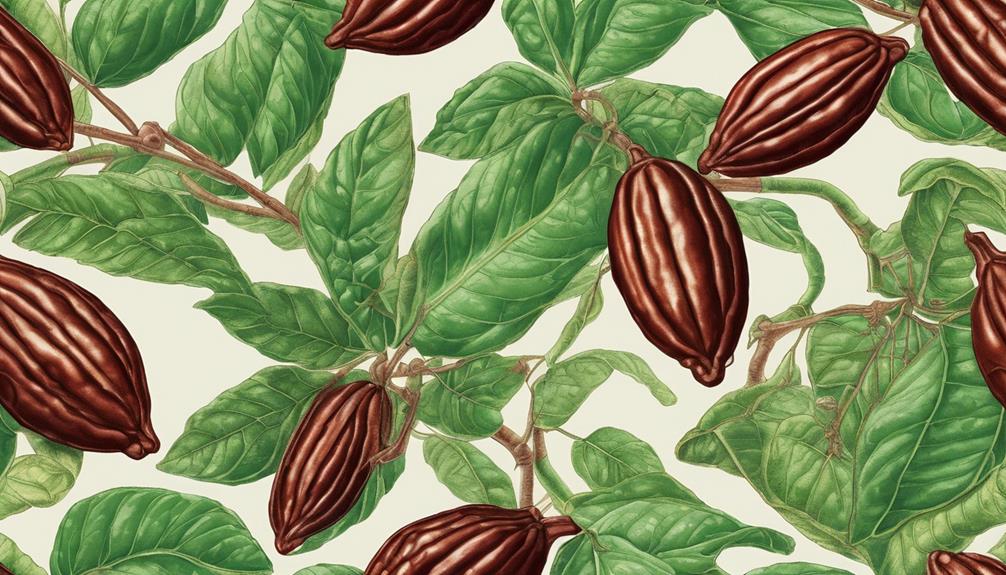
Theobromine and caffeine are two key compounds found in cocoa that affect our bodies differently. While theobromine provides a gentler stimulant effect, caffeine delivers a more pronounced jolt of energy.
Understanding the distinctions between theobromine and caffeine in cocoa can help us appreciate the complex interplay of these substances in our favorite chocolate treats.
Theobromine Effects
Cocoa beans contain theobromine, a compound with a gentler stimulating effect compared to caffeine. When indulging in chocolate, the theobromine present contributes to the pleasurable experience, possibly enhancing feelings of relaxation and happiness.
This compound, naturally found in cocoa beans alongside caffeine, adds to the allure of consuming chocolate products. Theobromine's effects on the body differ from caffeine, providing a unique experience when enjoying cocoa-based treats.
Caffeine Levels Comparison
Comparing the caffeine levels in cocoa powder to theobromine reveals distinct differences in their stimulant potency. Cocoa powder contains caffeine ranging from 0.1-0.5%, with an average caffeine content in cocoa beans of 0.214%.
Theobromine, on the other hand, found in cocoa beans, has a milder stimulant effect than caffeine. Well-fermented African cocoa beans tend to have lower caffeine levels in cocoa powder compared to other varieties.
It should be emphasized that cocoa has more caffeine than chocolate due to the concentration of cocoa solids in cocoa powder. Understanding these differences in caffeine levels and stimulant effects can help individuals make informed choices regarding their consumption of cocoa products.
Health Benefits Breakdown
Indulging in cocoa-based treats offers a unique blend of stimulant compounds that contribute to both relaxation and happiness. When it comes to the health benefits of cocoa, understanding the differences between theobromine and caffeine is key. Here's a breakdown:
- Theobromine, present in cocoa, provides a gentler stimulant effect than caffeine.
- Cocoa contains a mix of theobromine and caffeine, offering a distinctive combination of stimulants.
- Theobromine plays a significant role in the pleasurable experience of enjoying chocolate products.
- Consuming cocoa-based treats rich in theobromine can promote feelings of contentment and well-being.
Health Implications of Caffeine in Cocoa
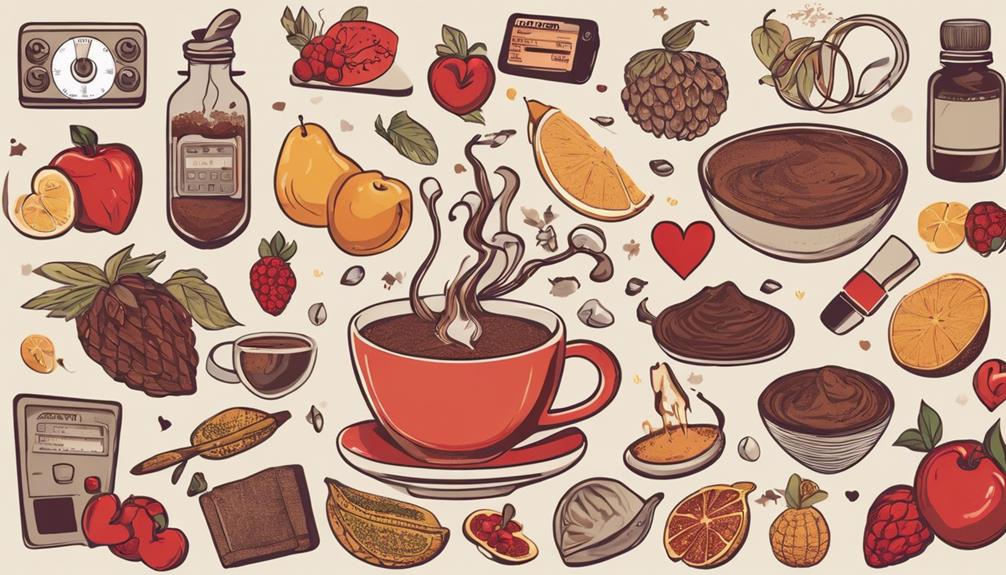
How does the caffeine present in cocoa powder impact our overall health and well-being?
The caffeine content in cocoa powder, around 12 milligrams per tablespoon, can have various effects on our bodies. This mild stimulant can help enhance mood, increase alertness, and even aid cognitive function. When consumed in moderation, the caffeine in cocoa powder contributes to potential health benefits like memory improvement.
Dark chocolate, with higher cocoa content, contains more caffeine and antioxidants beneficial for heart health. Unlike coffee, cocoa powder provides a quick pick-me-up without the jitters associated with higher caffeine levels. It's essential to enjoy cocoa powder and dark chocolate in moderation to reap the benefits of caffeine and antioxidants while avoiding excessive sugar and calorie intake.
Caffeine in Hot Chocolate Vs. Other Beverages
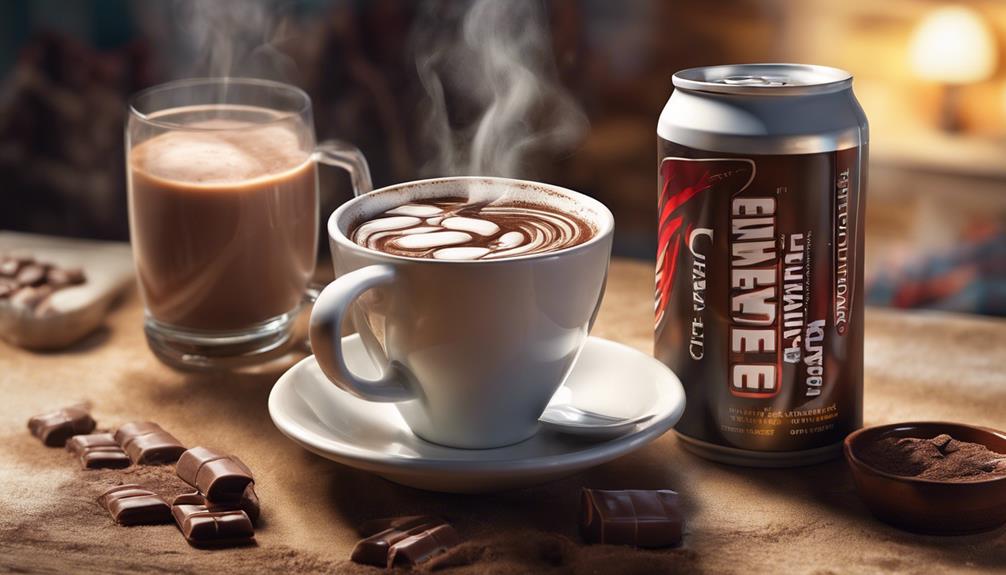
While hot chocolate may not pack as much caffeine as coffee, it still offers a comforting beverage option with a gentle energy boost. Here are some comparisons to give you a better idea of the caffeine content in hot chocolate versus other popular hot beverages:
- Hot chocolate contains 7.44 milligrams of caffeine per cup, much lower than coffee's 96 milligrams.
- A tall Starbucks hot chocolate has 20 milligrams of caffeine, notably less than Pike Place coffee's 235 milligrams.
- Hot chai tea with milk has 21.6 milligrams of caffeine per cup, slightly more than hot chocolate.
- While hot chocolate isn't as caffeinated as coffee or chai tea, it can be higher in sugar compared to unsweetened tea or coffee.
Understanding the caffeine levels in different hot beverages can help you make informed choices based on your preferences and caffeine tolerance.
Enjoy your hot chocolate knowing it provides a gentle energy lift without the same caffeine punch as other options.
Myths and Facts About Cocoa and Caffeine
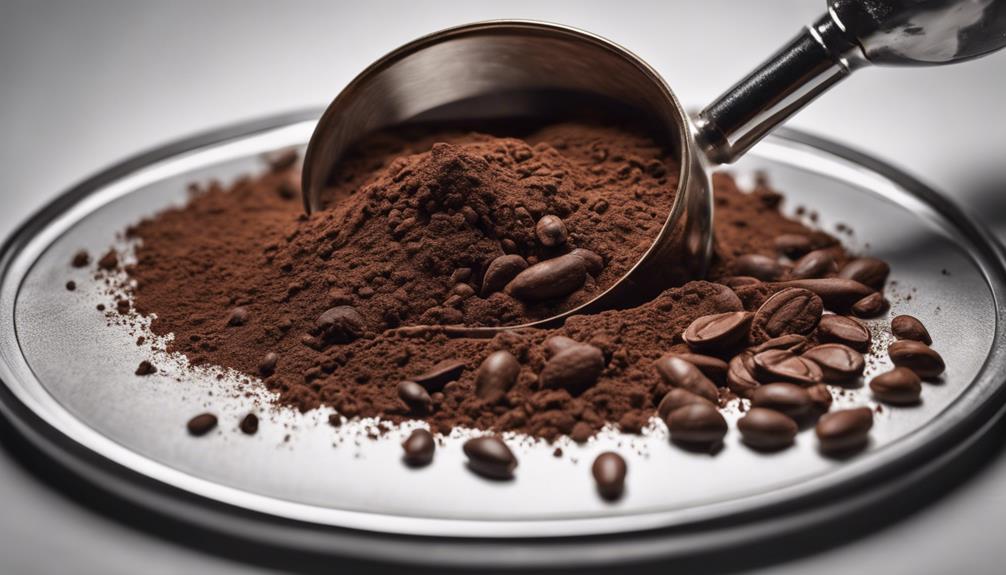
Cocoa powder, a common ingredient in many desserts, contains caffeine levels ranging from 0.1-0.5%. Despite popular belief, well-fermented African cocoa beans actually have lower caffeine levels in cocoa powder.
Another common misconception is that chocolate bars contain more caffeine than cocoa powder; in reality, cocoa itself has a higher caffeine content. The processing techniques used can also impact the caffeine levels in cocoa products. For instance, natural cocoa powders generally have higher caffeine levels compared to chocolates due to the differences in processing methods.
It's essential to note that caffeine in cocoa is naturally occurring and not added during production. When consumed in moderation, the caffeine in cocoa is unlikely to pose any significant health risks, unless individuals have specific health conditions that require them to monitor their caffeine intake carefully.
Frequently Asked Questions
Is There Any Caffeine in Cocoa Powder?
Yes, there is caffeine in cocoa powder. It typically contains 0.1% to 0.5% caffeine. A tablespoon of cocoa powder can offer around 12 milligrams of caffeine. Well-fermented African cocoa beans usually have lower caffeine levels.
How Much Caffeine Is in Dutch Processed Cocoa?
I've found that Dutch processed cocoa contains about half the caffeine of natural cocoa powder. It's perfect for recipes needing a milder taste and darker hue. I appreciate its lower caffeine content, making it my go-to choice for baking.
How Do You Remove Caffeine From Cocoa Powder?
I remove caffeine from cocoa powder using decaffeination methods like ethyl acetate or water-based processes. These methods aim to preserve flavor compounds while eliminating caffeine content. Decaffeinated cocoa powder retains its rich chocolate taste without the stimulating effects of caffeine.
What Is the Caffeine Like Substance in Cocoa?
Feeling cozy with cocoa? The caffeine-like substance in cocoa is theobromine. It's like a gentle nudge, not a jolt like caffeine. Theobromine adds to the chocolatey delight, giving a milder lift for that sweet indulgence.
Is Caffeine Content in Cacao Nibs Similar to Cocoa Powder?
Yes, the surprising caffeine content in cacao is similar to cocoa powder. Cacao nibs contain about 12 mg of caffeine per ounce, while cocoa powder contains around 12-20 mg per ounce. Both are sources of natural caffeine, but the content can vary based on how the cacao is processed.
Conclusion
To sum up, understanding the caffeine content in cocoa powder is crucial for making informed choices about your beverages. Remember that cocoa contains caffeine, but the levels are lower than coffee and tea.
Theobromine, another stimulant in cocoa, also plays a role in its effects. When enjoying hot chocolate or other chocolate products, be mindful of your caffeine intake.
By being aware of these facts, you can savor your cocoa treats with knowledge and moderation.

